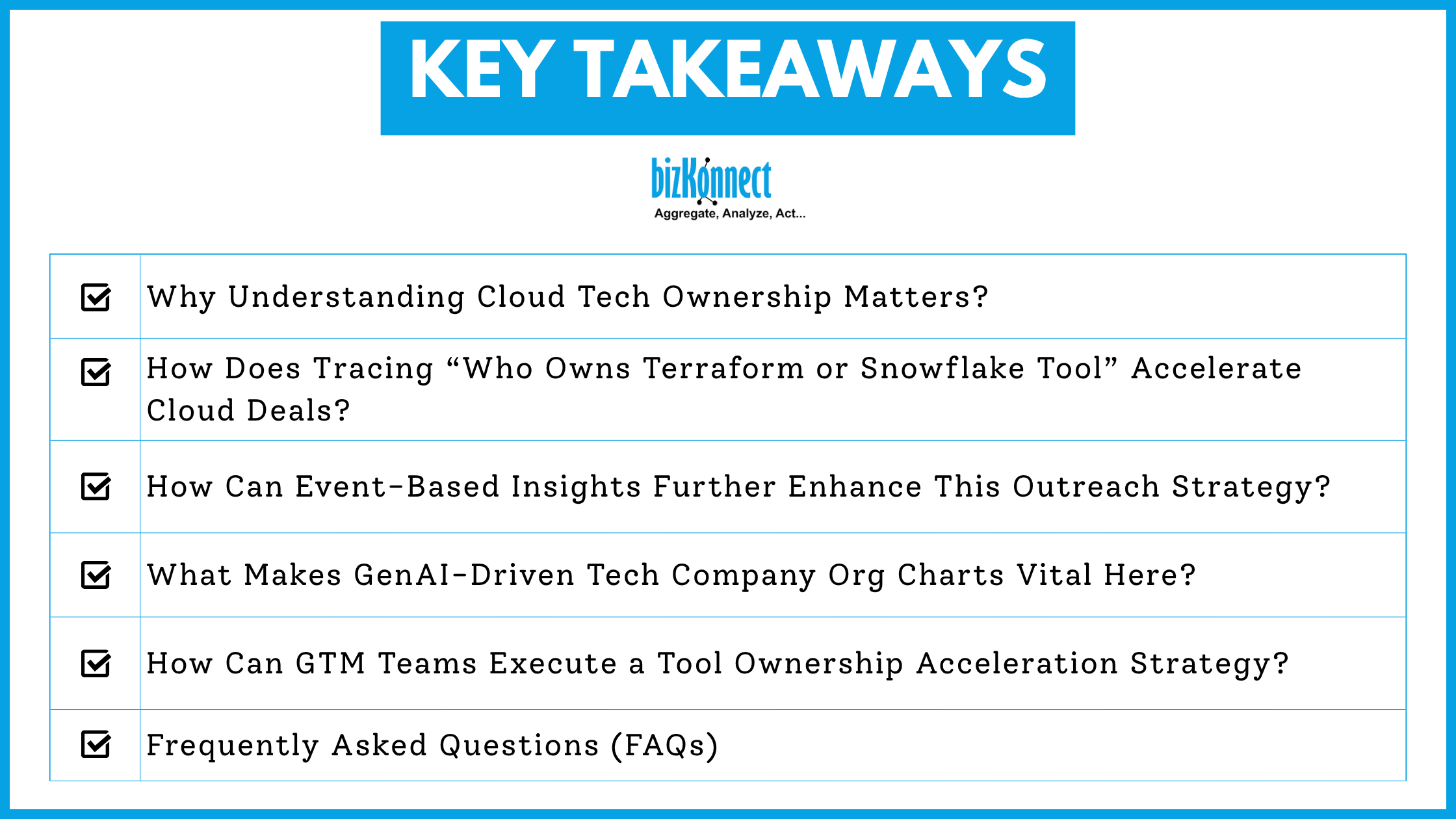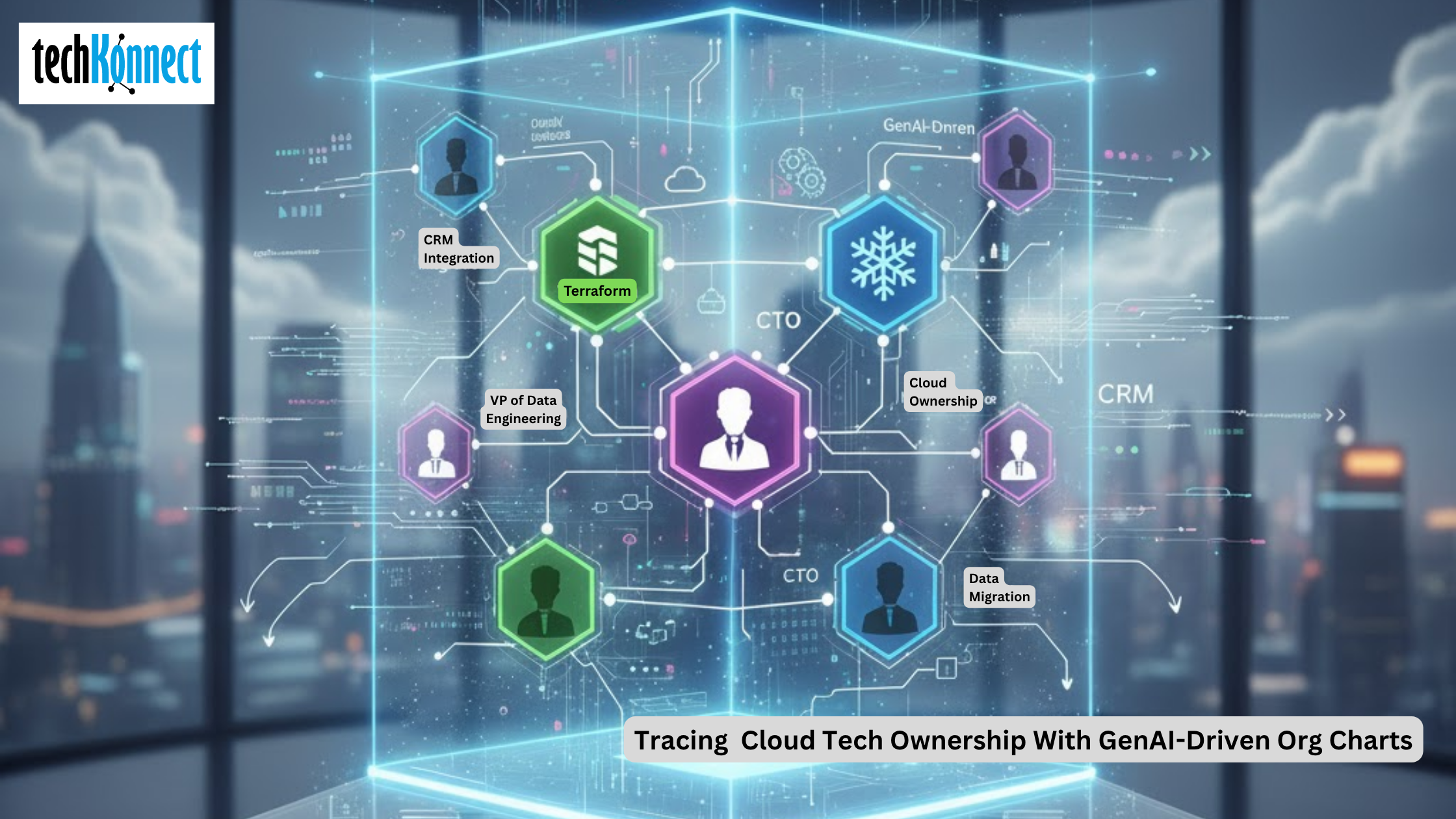When it comes to tech enterprise sales conversation today, timing rarely decides everything: context does. Sellers who know not just which tools from Terraform to Snowflake a company uses but who own them cut through bureaucracy faster, personalize their outreach better, and turn discovery calls into meaningful deals.

Here GenAI-driven tech company org charts redefine modern go-to-market motion. They allow you to visualize entire enterprise tech ecosystems, revealing who’s responsible for CRM integration, cloud transformation, or data migration. So, your outreach lands exactly where tech ownership lives, accelerating your cloud deals and boosting overall ROI.
But what does it really matter to trace tech ownership smartly, and how can it transform deal velocity? Let’s unpack the layers of this opportunity.
Why Understanding Cloud Tech Ownership Matters?
Every tool in the cloud stack has multiple owners:
- Economic owners (e.g., VP of Data Engineering controlling Snowflake budget)
- Technical champions (e.g., Director of Cloud Infrastructure driving Terraform adoption)
- Executive sponsors (e.g., Chief Data Officer or CTO approving migrations)
Without visibility into these roles, outreach loses precision. Messages land in the wrong inboxes, deals stall, and follow-ups fail to align with buyer priorities.
- B2B data decays at over 70% per year
- Average buying groups now involve 10–11 decision-makers
- Up to 40% of sales effort is wasted finding the right contact
By mapping cloud tech owners like VP of Data Engineering and Director of Cloud Infrastructure, teams can identify the economic buyer, technical champion, and initiative sponsor for each tool, making outreach accurate and relevant.
How Does Tracing “Who Owns Terraform or Snowflake Tool” Accelerate Cloud Deals?
Knowing who controls specific cloud tech allows teams to communicate outcomes that matter to each stakeholder. For example:
- VP of Data Engineering: Focus on Snowflake optimization, cost savings, and data governance.
- CTO: Highlight scalability, architecture alignment, and tech stack integration.
- CFO: Present ROI, total cost of ownership (TCO), and budget justification.
Here, using detailed organizational charts of top technology companies helps GTM teams to identify these cloud tech buyers instantly (e.g., Terraform integration requires VP of Infrastructure approval). Also, it helps to build multi-threaded relationships to reduce deal risk.
Research shows that companies using this approach report up to 40% shorter sales cycles.
How Can Event-Based Insights Further Enhance This Outreach Strategy?
Industry events such asAWS re:Invent, PASS Summit, and AI Weekprovide signals on active initiatives. Combining event attendance with cloud tech ownership insights allows GTM teams to:
- Detect when cloud initiatives are underway (e.g., Director of Cloud Engineering at AWS re:Invent signals Terraform adoption).
- Identify upcoming investments (e.g., PASS Summit attendance may indicate Snowflake expansions).
- Align outreach with intent and budget timing, improving connect rates and deal qualification.
This approach ensures outreach is contextual, timely, and highly relevant, not just volume-based.

What Makes GenAI-Driven Tech Company Org Charts Vital Here?
While traditional generic lists can’t keep pace with the fast-changing ownership of platforms like Terraform or Snowflake, GenAI org charts go further. They offer dynamic and contextual insights into:
- Reporting Lines: Who reports to whom and who signs off on budgets
- Budget Ownership: Who controls Terraform, Snowflake, or Kubernetes spend
- Initiative Tracking: Who sponsors projects like Cloud Migration, AI Modernization, or FinOps Implementation
With this data, GTM teams can operate strategically, targeting validated buyers with relevant messaging, reducing wasted meetings, and accelerating the path to close.
How Can GTM Teams Execute a Tool Ownership Acceleration Strategy?
This strategy works as a repeatable process:
- Map Your Target Stack: Identify key technologies (Terraform, Snowflake, Databricks) for your ICP.
- Overlay Dynamic Org Data: Connect tool ownership to decision hierarchies using org charts.
- Activate Event Intelligence: Use AWS, PASS, and AI Week participation to find intent signals.
- Segment and Personalize: Align messaging to roles (technical, financial, operational).
- Measure Multi-Thread Depth: Track stakeholder coverage and engagement velocity across the organization.
This structured, data-driven approach ensures GTM teams reach decision-makers when relevance is highest, accelerating deals and reducing wasted outreach.
Frequently Asked Questions (FAQs)
Q1. What defines a modern "Tech Company Org Chart" versus a traditional one?
A modern chart is dynamic, GenAI-driven, and layered with accurate data, showing reporting lines, budget ownership, technology adoption (like Terraform/Snowflake usage), and active initiatives. A traditional chart is static and manually updated, only showing basic reporting structure.
Q2. Why is knowing the budget owner for a platform like Snowflake so crucial?
It's crucial because it allows the sales team to tailor the value proposition directly to the financial impact and ROI that matters to the budget holder. It prevents wasted time on pitching technical features to non-financial stakeholders, thereby accelerating the deal.
Q3. How does this level of insight impact marketing strategy?
It enables precise ABM by segmenting campaigns based on specific technology usage (e.g., targeting Terraform users) and project sponsorship. This ensures content is highly relevant to a prospect's current, funded needs.
Stop guessing the org structure. See how BizKonnect reveals decision chains using GenAI. FREE SAMPLE.